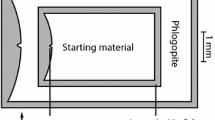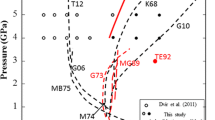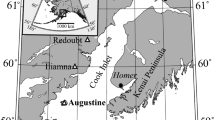Summary
Supra-solidus phase relations at temperatures and pressures ranging from 800 to 1700 °C and 2 to 6.4 GPa have been determined experimentally for three silica-rich lamproites: hyalo-leucite phlogopite lamproite (Oscar, West Kimberley); sanidine richterite lamproite (Cancarix, Murcia-Almeria); and phlogopite transitional madupitic lamproite (Middle Table Mountain, Wyoming). All samples have extended melting intervals (500–600 °C). Bulk composition has a significant control on the nature of the initial liquidus phases, with orthopyroxene occurring at low pressures (<4 GPa) in the relatively calcium-poor Oscar and Cancarix lamproites. At higher pressure (>6 GPa) orthopyroxene is replaced by garnet plus clinopyroxene as near-liquidus phases in the Oscar lamproite and by orthopyroxene plus clinopyroxene in the Cancarix sample. Clinopyroxene is a near-liquidus phase at all pressures in the Middle Table Mountain lamproite. Near-solidus phase assemblages at high pressure (>5 GPa) are: clinopyroxene + phlogopite + coesite + rutile + garnet (Oscar); clinopyroxene + garnet + coesite + K–Ti-silicate (Cancarix); clinopyroxene + phlogopite + apatite + K–Ti-silicate (Middle Table Mountain). In all compositions olivine is never found as a liquidus phase at any of the temperatures or pressures studied here. The phase relationships are interpreted to suggest that silica-rich lamproites cannot be derived by the partial melting of lherzolitic sources. Their genesis is considered to involve high degrees of partial melting of ancient metasomatic veins within a harzburgitic-lherzolitic lithospheric substrate mantle. The veins are considered in their mineralogy to be similar to the experimentally-observed, high pressure, near-solidus phase assemblages. The composition of silica-rich primary lamproite magmas differs between cratons as a consequence of differing mineralogical modes of the source veins and different relative contributions from the veins and wall-rocks to the partial melts.
Similar content being viewed by others
Author information
Authors and Affiliations
Additional information
Received February 21, 2000; revised version accepted July 3, 2001
Rights and permissions
About this article
Cite this article
Mitchell, R., Edgar, A. Melting experiments on SiO2-rich lamproites to 6.4 GPa and their bearing on the sources of lamproite magmas. Mineralogy and Petrology 74, 115–128 (2002). https://doi.org/10.1007/s007100200000
Issue Date:
DOI: https://doi.org/10.1007/s007100200000




